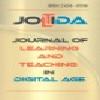Virtual Dissection Table: A Supplemental Learning Aid for a Physical Therapy Anatomy Course
Virtual Dissection Table: A Supplemental Learning Aid for a Physical Therapy Anatomy Course
Virtual Dissection Table, , Physical Therapy, Anatomy Teaching, Teaching and Learning Experience Technology,
___
- Afsharpour, S., Gonsalves, A., Hosek, R., & Partin, E. (2018). Analysis of immediate student outcomes following a change in gross anatomy laboratory teaching methodology. The Journal of Chiropractic Education, 32(2), 98–106. https://doi.org/10.7899/JCE-17-7.
- Anatomage [Internet] (2019). [accessed 2021 February 15]. Available from: https://www.anatomage.com/ Bairamian, D., Liu, S., & Eftekhar, B. (2019) Virtual Reality Angiogram vs 3-Dimensional Printed Angiogram as an Educational tool-A Comparative Study. Neurosurgery, 85(2), 343-349.
- Berkowitz, S. J., Kung, J. W., Eisenberg, R. L., Donohoe, K., Tsai, L. L., & Slanetz, P. J. (2014). Resident iPad use: has it really changed the game?. Journal of the American College of Radiology, 11(2), 180-184.
- Bork, F., Stratmann, L., Enssle, S., Eck, U., Navab, N., Waschke, J., & Kugelmann, D. (2019). The Benefits of an Augmented Reality Magic Mirror System for Integrated Radiology Teaching in Gross Anatomy. Anatomical Science Education, 12(6), 585-598.
- Brucoli, M. Boffano, P., Pezzana, A., Sedran, L., Boccafoschi, F., & Benech, A. (2020). The potentialities of the Anatomage Table for head and neck pathology: medical education and informed consent. Oral and Maxillofacial Surgery, 24(2), 229-234.
- Brucoli, M., Boccafoschi, F., Boffano, P.; Broccardo, E., & Benech, A. (2018) The Anatomage Table and the placement of titanium mesh for the management of orbital floor fractures. Oral Surg Oral Med Oral Pathol Oral Radiol, 126(4), 317-321.
- Chakraborty, T. R., & Cooperstein, D. F. (2018). Exploring anatomy and physiology using iPad applications. American Association of Anatomists, 11, 336-345. doi:10.1002/ase.1747
- Custer T., & Michael K. (2015). The Utilization of the Anatomage Virtual Dissection Table in the Education of Imaging Science Students. Journal of Tomography & Simulation, 1, 102. doi:10.4172/jts.1000102.
- Darras K.E., Spouge R., Hatala R., Nicolaou S., Hu J., Worthington A., Krebs C., & Forster B.B. (2019) Integrated virtual and cadaveric dissection laboratories enhance first year medical students' anatomy experience: a pilot study. BMC medical education, 19(1), 366. doi: 10.1186/s12909-019-1806-5.
- Duncan-Vaidya E. A., & Stevenson E. L. (2020) The Effectiveness of an Augmented Reality Head-Mounted Display in Learning Skull Anatomy at a Community College. Anatomical Science Education, doi: 10.1002/ase.1998.
- Ghosh S. K. (2015). Human cadaveric dissection: a historical account from ancient Greece to the modern era. Anatomy & Cell Biology, 48(3), 153-69.
- Ha, J.E., & Choi, D.Y. (2019) Educational effect of 3D applications as a teaching aid for anatomical practice for dental hygiene students. Anatomy & cell biology, 52(4), 414-418.
- Hammond, I., Taylor, J., & McMenamin, P. (2003). Anatomy of complications workshop: An educational strategy to improve performance in obstetricians and gynaecologists. Australian and New Zealand Journal of obstetrics and Gynaecology, 43(2), 111-114.
- Houser, J.J., & Kondrashov, P. (2018). Gross Anatomy Education Today: The Integration of Traditional and Innovative Methodologies. Missouri Medicine, 115(1), 61-65.
- Iwanaga J., Loukas M., Dumont A.S., & Tubbs R.S. (2020) A review of anatomy education during and after the COVID-19 pandemic: Revisiting traditional and modern methods to achieve future innovation [published online ahead of print, Jul 18]. Clinical Anatomy, 34(1), 108-114.
- Krause, B., Riley, M., & Taylor, M. (2015). Enhancing Clinical Gross Anatomy through Mobile Learning and Digital Media. The FASEB Journal, 29, 550-3.
- Mathis, M.., Gonzalez-Sola, M., & Rosario, M. (2020). Anatomy Observational Outreach: A Multimodal Activity to Enhance Anatomical Education in Undergraduate Students. Journal of Student Research, 9(1). https://doi.org/10.47611/jsr.v9i1.869
- Minhas P. S., Ghosh A, & Swanzy L. (2012). The effects of passive and active learning on student preference and performance in an undergraduate basic science course. Anatomical Science Education, 5(4), 200-7. doi: 10.1002/ase.1274.
- Rosario, M. G., Gonzalez‐Sola, M., Hyder, A., Medley, A., & Weber M. (2019). Anatomage Virtual Dissection Table: a Supplemental Learning Aid for Human Anatomy Education during an Undergraduate Outreach Activity. First published: 01 April 2019 https://doi.org/10.1096/fasebj.2019.33.1_supplement.604.9 Vol 33 Issue S1
- Rosario, M. (2021). The Perceived Benefit of a 3D Anatomy Application (App) in Anatomy Occupational Therapy Courses. Journal of Learning and Teaching in Digital Age, 6 (1), 8-14. Retrieved from https://dergipark.org.tr/en/pub/joltida/issue/59433/853789
- Schofield K. A. (2018). Anatomy education in occupational therapy curricula: Perspectives of practitioners in the United States. Anatomical Sciences Education, 11(3), 243–253. https://doi.org/10.1002/ase.1723
- Sugand, K., Abrahms, P., & Khurana, A. (2010). The anatomy of anatomy: A review for its modernizations. Anatomical Sciences Education, 3, 83-93. https://anatomypubs.onlinelibrary.wiley.com/doi/pdf/10.1002/ase.139
- Smith, C.F., Martinez-Álvarez, C., & McHanwell, S. (2013). The context of learning anatomy: does it make a difference?. Journal of Anatomy, 224(3), 270-8.
- Peterson D.C., & Mlynarczyk G.S. (2016) Analysis of traditional versus three-dimensional augmented curriculum on anatomical learning outcome measures. Anatomical Science Education, 9(6), 529-536. doi:10.1002/ase.1612.
- Uruthiralingam, U., & Rea, P. M. (2020). Augmented and Virtual Reality in Anatomical Education–A Systematic Review. Biomedical Visualisation, 89-101.
- Ward, T.M., Wertz, C.I., & Mickelsen, W. (2018). Anatomage Table Enhances Radiologic Technology Education. Radiologic technology, 89(3) 304-306.
- Texas Woman’s University [Internet] (2021). Available from: https://twu.edu/ [accessed February 15, 2021].
- Yayın Aralığı: 2
- Başlangıç: 2016
- Yayıncı: Mehmet Akif Ocak
The Role of Multimedia in Concept Learning from the Parents’ Perspective
Virtual Dissection Table: A Supplemental Learning Aid for a Physical Therapy Anatomy Course
Educational Computer Game for Eartquake
Ebru YILMAZ İNCE, Murat Emre SANCAK
Postgraduate Theses on Digital Literacy in Turkey: A Content Analysis Study
Mithat ELÇİÇEK, Mustafa KAHYAOĞLU
Students’ Views Regarding Instruction during the Pandemic Process
Funda HASANÇEBİ, Mehmet YAVUZ, Bünyami KAYALI, Mehmet HASANÇEBİ, Özgür TUTAL, Abdurrahim ÖZKILIÇ
Meral ŞEKER, Banu INAN KARAGÜL
Two Decades of Computing at the University of Belize
A Systematic Review of Tech-supported Collaborative Creativity Practices in the Field of Education
